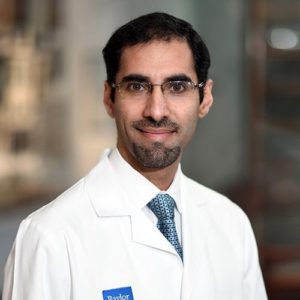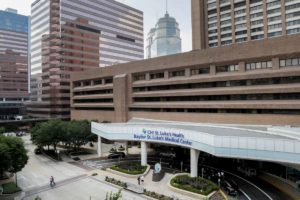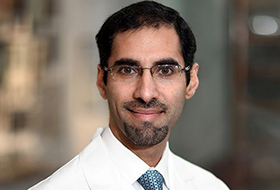I thoroughly enjoyed my conversation with Dr. Atif Iqbal, Chief of the Colorectal Surgery Program at Baylor College of Medicine, as we discussed his utilization of a comprehensive enhanced recovery after surgery (ERAS) protocol, which facilitates opioid-free recovery. Our conversation is summarized below:

Tell us about yourself—what is your background and what sparked your interest in acute pain management?
I am a Colorectal Surgeon who got interested in outcomes-based surgical research during a research fellowship at Creighton University in Nebraska, and subsequently during my training at the University of Missouri and Washington University/Barnes Jewish Hospital in Missouri. Before I came to Baylor, I was at the University of Florida for seven years and that is where I truly got involved in efforts to improve the perioperative experience.
The surgical patient population expects absolute pain control after surgery and historically, we as surgeons prescribed large quantities of opioids to help patients manage their pain. Surgeons are beasts of habit. A surgeon does not want to harm a patient, so the tendency is to keep doing what is safe and learned from predecessors. Even though data shows that a patient can go through and heal from surgery with little or no opioids after surgery, it doesn’t happen frequently enough.
I wanted to move away from that treatment paradigm because my patients experienced opioid-related adverse drug events (ORADEs) such as nausea, vomiting, and constipation following opioid use. ORADEs led to my patients having an increased length of stay (LOS) post-surgery. As most of my patients were undergoing elective, or scheduled surgeries, I had an opportunity to talk to them before surgery and educate them about postsurgical pain management at each phase of care.
During this time, I learned more about ERAS protocols from colleagues at Duke and Vanderbilt and decided to implement them at our facility. The process starts well before surgery, specifically in the clinic when the patient comes to discuss surgery. Setting realistic expectations and outlining a pain management plan takes a lot of stress away for the patients. Many of my patients start taking non-opioid medications for pain, even before they come to the hospital. Right before surgery, they receive spinal anesthesia and then the multimodal non-opioid therapy is continued during and after surgery.
We found that approximately one-third of patients were using opioids to manage their pain, even prior to surgery. However, after we implemented an ERAS pathway, we observed a 62% decrease in patients using any opioids after surgery; those who did use opioids witnessed a 99% reduction in opioid consumption compared to before ERAS implementation. More importantly, the patients were happy, their pain was well-managed, and they reported satisfaction in their care which was equivalent to before ERAS. No compromise in pain control was noted as a result of this protocol. In addition, patients were able to get up and moving quicker and returned home sooner; one to three days after surgery instead of the historic five- to seven-day hospital stay of the past.
Can you tell us a bit about your hospital?

Baylor College of Medicine/Baylor St Luke’s Medical Center is an academic institution and a tertiary care facility in Houston, Texas. The Colorectal Surgery Program at Baylor attracts patients from all over the state and beyond for treatment of a range of colorectal diseases from colorectal cancer to inflammatory bowel disease to anorectal pathology. We tend to treat patients with complicated diseases who have had prior treatment elsewhere. Even though most of our procedures are done with minimally invasive techniques, pain is still an inherent part of surgery. I have instituted a comprehensive ERAS protocol at Baylor as well. Despite doing more complicated procedures, our patients are utilizing less opioids, going home sooner, and tend to have less complications.
What patient populations do you serve?
I treat both adult-aged (18+) men and women. The specific age range will depend on the reason they are seeing me. More patients with colorectal cancer are on the older side and those with inflammatory bowel disease are on the younger side, but this is not always the case. Being in the Texas Medical Center, one of the largest life science destinations in the world, I encounter patients from all walks of life, ethnicities, cultures, financial and social backgrounds.
What inspired you to create a non-opioid perioperative pain management experience for patients?
It was simply the right thing to do! As I mentioned before, I discussed and learned from my colleagues at Vanderbilt and Duke and was inspired to implement this strategy first at the University of Florida and now here at Baylor College of Medicine. The results, though hard to envision conceptually, are real.
What positive downstream affects have you seen since you implemented your program?
I have seen a decrease in length of stay, readmission rates, and different complications. Our ambulation protocols to get patients up and moving have my patients moving around more after surgery, which results in lower incidences of hospital-associated blood clots, pneumonia, and hospital-acquired infections. Additionally, patients are more lucid, attentive and happy when needing minimal to no opioids.
What are the next steps and future directions?

- I still need to focus on the small group that continues to need opioids after surgery. They are primarily the individuals who are taking opioids prior to their procedure and often need to go home with some.
- It is crucial to drum up federal support to encourage hospitals to invest in opioid-sparing techniques and medications. It can be hard to do a randomized clinical trial in support of these techniques without hospital buy-in.
- Locally, I plan to continue to push the needle by educating everyone involved in the surgical process, including physicians, staff, and patients.
- We are in the process of developing videos describing the perioperative process to patients, including capturing patient testimonials about the benefits of opioid-sparing protocols. This would help better engage patients and decrease their anxiety.
- We have also started implementing protocols for early and aggressive ambulation of patients after surgery to help decrease complications after surgery.
- The next step would be to push the envelope further in terms of decreasing or potentially eliminating the patient’s hospital stay altogether after surgery. We are developing protocols to that effect as well.



